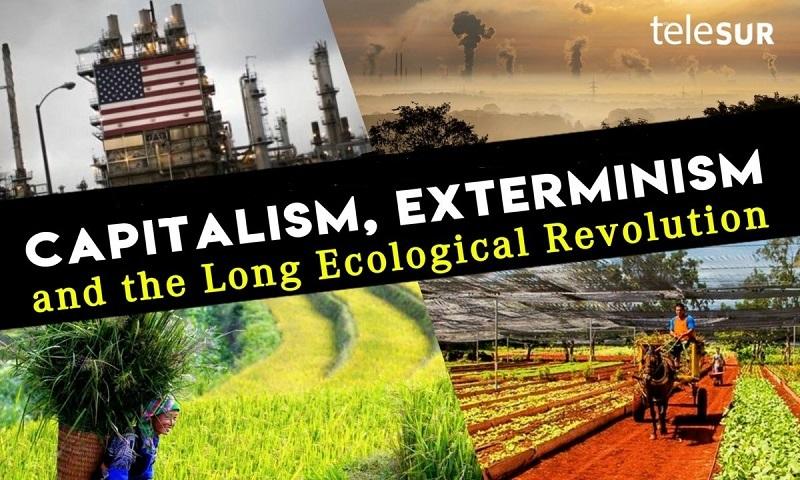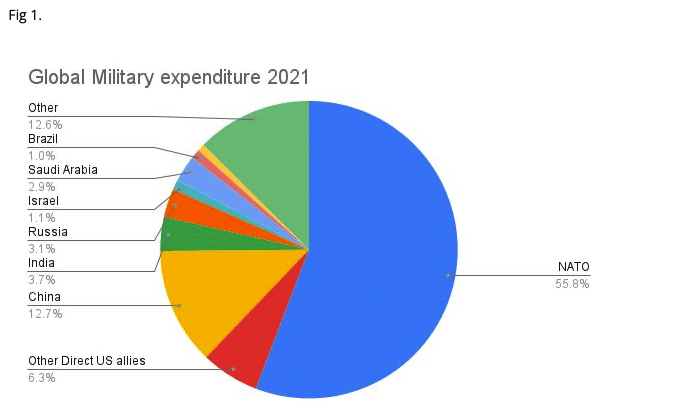Ecocide is the deliberate destruction of an environment so that it can no longer sustain life.
The attempt by the United States to maintain its global domination and its fatally outmoded model of modernity for others to emulate could commit this in two ways.
- Ecological collapse through climate breakdown
- War
The former is already taking place and accelerating; providing a medium to long term prospect of civilisational collapse if we just carry on as we are. But it is also having an immediate and increasingly severe impact now and addressing it can’t be put off. The latter is a clear, present and growing danger built into the U.S. attempt to reassert its slipping economic grip through increased military aggression.
And the two ways are linked. The “civil war” that has devastated Syria since 2011 was partly caused by the mass displacement of rural communities into the cities by a prolonged drought that made farming impossible. The current El Nino is leading to a sharp upward spike in global temperatures that has seen heatwaves so severe that workers in Milan and Texas have dropped dead in the street; heralding the prospect that capacity for outdoor work across the world could be cut 40% by mid century. These heatwaves are likely to lead to problems with harvests in the next eighteen months; which could produce famines in the most vulnerable areas, but are likely to lead to shortages and increased costs everywhere.
Even without the additional destruction caused by warfare, the ongoing normal functioning of capitalism is already committing ecocide on a planetary scale. This can be seen in the two thirds collapse of vertebrate wildlife species since 1970 (84% for freshwater species) and the similarly alarming drop in insect populations; on which plants, wild and cultivated, depend for pollination. The definition of a mass extinction is that 75% of species die out within two million years. While the decline in animal life since 1970 is in overall numbers rather than species, 69% in fifty years is terrifyingly fast.

Given that ecosystems rely on a complex web of diverse interactions to stay viable, all of this is pulling the web of life apart to a point that it is breaking in places. The replacement of the complex diversity of rain forests by palm oil mono-cultures, or soya farming, does enormous damage even before the residual forests degrade to savannah or desert.
This cannot be separated from economic viability either. According to an analysis by the Swiss Re Institute in 2020,
- Over half (55%) of global GDP, equal to USD 41.7 trillion , is dependent on high-functioning biodiversity and ecosystem services
- But “a staggering fifth of countries globally (20%) are at risk of their ecosystems collapsing due to a decline in biodiversity and related beneficial services
The analysis went further in assessing which countries have the highest proportion of degraded, fragile, vulnerable ecosystems. 39 countries have ecosystems in a fragile state on more than a third of their land—Malta, Israel, Cyprus, Bahrain and Kazakhstan have the lowest Biodiversity and Ecosystems Services (BES) ranking. The most degraded among the G20 economies are.
- South Africa 40% of land area is fragile
- Australia 32% fragile
- India 28% fragile
- Turkey 24% fragile
- Mexico 24% fragile
If South Africa, with 61 million people, or Australia, with 26 million, were to face partial or total ecological breakdown that would be disastrous enough; but if India, with 1.4 billion people, did, the global impact would be uncontainable.
Combine this with the impacts of global heating and we have a prospect of countries collapsing. Not all at once, but weakest links first.
The U.S. military assessment of the security implications of climate change posits large areas of Africa, Asia and the Middle East becoming unstable because of water shortages—and it is making contingency plans to ensure a supply of bottled water for U.S. forces they presume will intervene there. They also recognise that beyond a certain point, the stress on infrastructure of extreme weather events will not be containable, that social collapse, even in the United States, will follow infrastructure collapse, and the army itself will be called upon to take the place of a no longer functioning civil society, and will itself fall apart under the strain of trying to do so. Having sketched out this prospect, they also plan to be ready to intervene in parts of the Arctic; to take advantage of new sources of the fossil fuels, that are causing the climate crisis, once the melting ice sheets expose them. The cognitive dissonance is almost dizzying.
And the resources that are urgently needed to put limits on the increase in global temperatures, roughly $4 trillion a year globally, are increasingly being diverted into military spending precisely by the countries with the greatest technological and economic capacity, led by the U.S. Instead of genuinely “leading the world”, the “West”, the “Global North”, the “International Community” (call them what you will) are putting their resources into sharply increasing their military capacity; when they already account for two thirds of global military expenditure. See Fig 1.

To unpack this.
- In 2021, NATO, the core military alliance of the Global North, already accounted for 55.8% of global military spending
- Other direct U.S. allies—with a mutual defence pact—accounted for another 6.3%
So, the direct U.S. centred military alliances account for three fifths of global military spending and yet they are now raising it further at unprecedented rates.
Specifically.
- The U.S. has raised military spending to $858 billion this year; up from $778 billion in 2020
- France has announced an increase from a projected €295 billion to €413 billion in the next seven years (an average of €59 billion a year)
- German spending is rising sharply, from €53 billion in 2021 to €100 billion in 2022 and is set to go further
- Japan aims to double its military spending by 2028 and is also debating whether to start deploying nuclear weapons
- The UK government’s aim is to increase military spending from 2.1% of GDP to 2.5% by 2030 even though it already has among the highest per capita military spends in the world
These are the world’s dominant imperial powers, acting in concert to sustain a “rules based international order” in which the rules are written in, and to suit, the Global North in general and Washington in particular. There are increasing tensions between them, as the particular benefits to Washington are imposing increasing costs on its subordinate allies, but this is a secondary contradiction.
The scale of the prioritisation of the military over environmental survival is measurable.
The United States spends more than 18 times as much on its military as it does on domestic green transition. The agreed U.S. military budget for 2023 is $858 billion. The investment in green transition earmarked by the Inflation Reduction Act is $369 billion between now and 2030. 858 multiplied by 8 years gives a total spend of $6864 billion by 2030. Divide that by the 369 billion to be invested in green transition and you get a ratio of 18.6 to 1. So, for every dollar spent on green transition in the United States, $18.60 is spent on preparing for war.
And this is seventy eight times the annual amount they have pledged to the Global South for climate impacts by 2024.
The contrast with China is instructive. China’s military budget for 2022 was $229 billion, according to Janes. The investment earmarked for green transition—for a carbon peak before 2030 and neutrality by 2060—is $450—570 billion a year, according to China Briefing. That gives a ratio of between just under 2 to 1 and 2.5 to 1: so, on average more than twice as much being invested in green transition as on the military.
That contrast is not much noted in the peace and climate movements inside the Global North, and it needs to be if we are to avoid being disoriented.
And that is simply the impact of military spending. The best that can be hoped for this expenditure is that it remains “dead weight” and doesn’t get used; because war itself is a form of ecocide. Nuclear war would not simply destroy human civilisation, but viable human life. John Bellamy Foster’s essay on Exterminism for the 21st Century is essential reading for anyone who has become blase about what might happen in such a war, or has argued themselves into a state of denial that “tactical” use of these weapons is viable, can be limited and not have a rapidly escalating dynamic to a global holocaust in a matter of hours.
U.S. nuclear war fighting doctrine aims for a massive “First Strike” to knock out retaliatory capacity in Russia or China. This is suicidal even if successful. As Bellamy Foster notes;
The outcome of a global thermonuclear exchange resulting in mega-fires in a hundred or more cities, it was discovered, could enormously reduce the average temperature of the earth by pushing soot and smoke into the atmosphere and blocking solar radiation. The climate would be altered much more abruptly and in the opposite direction from global warming, introducing a rapid global cooling causing global (or at least hemispheric) temperatures to drop by several degrees or even “several tens of degrees” Celsius in a matter of a month, with horrific consequences for life on Earth. Thus, although hundreds of millions, perhaps even a billion or more people, would be killed by the direct effects of a global thermonuclear exchange, the indirect effects would be far worse, annihilating most people on the planet, even those not caught up in the direct effects of nuclear firebombs, via starvation.
The drive to rearm goes along with a drive to provoke wars. We have seen this in Ukraine. We can see it in the South China Sea. Pushing back against the U.S. war drive must be a central task for the climate, as well as, peace movement. Concrete demands to measure the global military carbon footprint, include it in the Paris Agreement, for freezes and limits and agreed reductions are all necessary to pull ourselves back from the brink of being killed by war before climate breakdown has the time to finish the job; and help provide the resources to stop it doing so.
In any war, every side will cause environmental damage. Accusing one side of committing ecocide while the other is presumed to fire shells that have no impact, is logically absurd. The Commission set up with the support of Greta Thunberg and Mary Robinson that seeks to “hold Russia accountable” for all ecological damage in Ukriane, regardless of who causes it, is dangerous. It gives a politico-military blank cheque to NATO. It will help prolong the war.
The way to stop the ecocide being caused by the Ukraine war is to stop the war. Stop sending weaponry and start sending peace negotiators.
Imperialism’s failure to act on climate change and the wars it has unleashed have already destroyed so much of the environment that many species have become extinct. It is urgent that climate action is taken and wars stopped, otherwise the degraded environment will increasingly be unable to sustain life.
Source: Monthly Review Online, Jul 21, 2023.
https://mronline.org/2023/07/21/ecocide-war-and-the-new-american-century/
